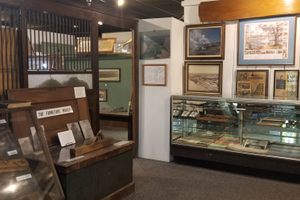In New Madrid, Missouri, it is evident that history unfolds both above and below ground. The New Madrid Historical Museum consistently makes this point, from showcasing the significance of its earliest inhabitants to the American Civil War to the fault line that runs beneath the town itself.
Although it focuses on three historical circumstances that converge at the Mississippi River banks, the primary driver of visitors to the museum arguably centers on the New Madrid Seismic Zone, which spans a distance of 150 miles and five states. Billboards for the museum offer boastful, pun-y signage, declaring “It’s Our Fault!” to those who happen to find themselves in town nearby.
The museum begins with two videos that introduce New Madrid, past, present, above, and below the earth. A major point of discussion is the 1811-1812 earthquakes, which written accounts and changes to the landscape show terrified residents for weeks and likely would have registered at least magnitude 7 on the yet-to-be-invented Richter scale.
The smallest exhibit features perhaps the least known topic: the Mississippians, the Indigenous people who first inhabited the riverbanks. They were mound builders whose civilization deteriorated long before the same river became the crossing point for the Trail of Tears, when Native Americans were forcibly relocated to “Indian Territory.” Historical markers near the museum indicate this was one of the few water crossings where many Native Americans, despite the deadly risk, were transported in unsafe boats.
Multiple rooms are devoted to Civil War history, the border-state status of Missouri, and the tactical significance of the river in the area. During the Civil War, to move troops more quickly, an underwater saw was leveraged to remove trees and clear swampy lands rather than reroute men. A replica of a submerged saw sits across the street from the museum.
Museumgoers eager to learn about the highly publicized and predicted 1990 earthquake will be disappointed. Exhibits do not give credence to Iben Browning’s theorized Dec. 3, 1990, massive earthquake. However, the museum’s docent is knowledgeable about the story and can answer any questions about what caused a self-proclaimed climatologist to arrive at his conclusions. And why so many listened.
While the “big one” didn’t happen in 1990, the New Madrid Historical Museum promotes preparedness and offers earthquake kits for purchase. History has proven that living in proximity to an awakened fault line impacts all life in its wake, and it is only a matter of when it will quake again.
